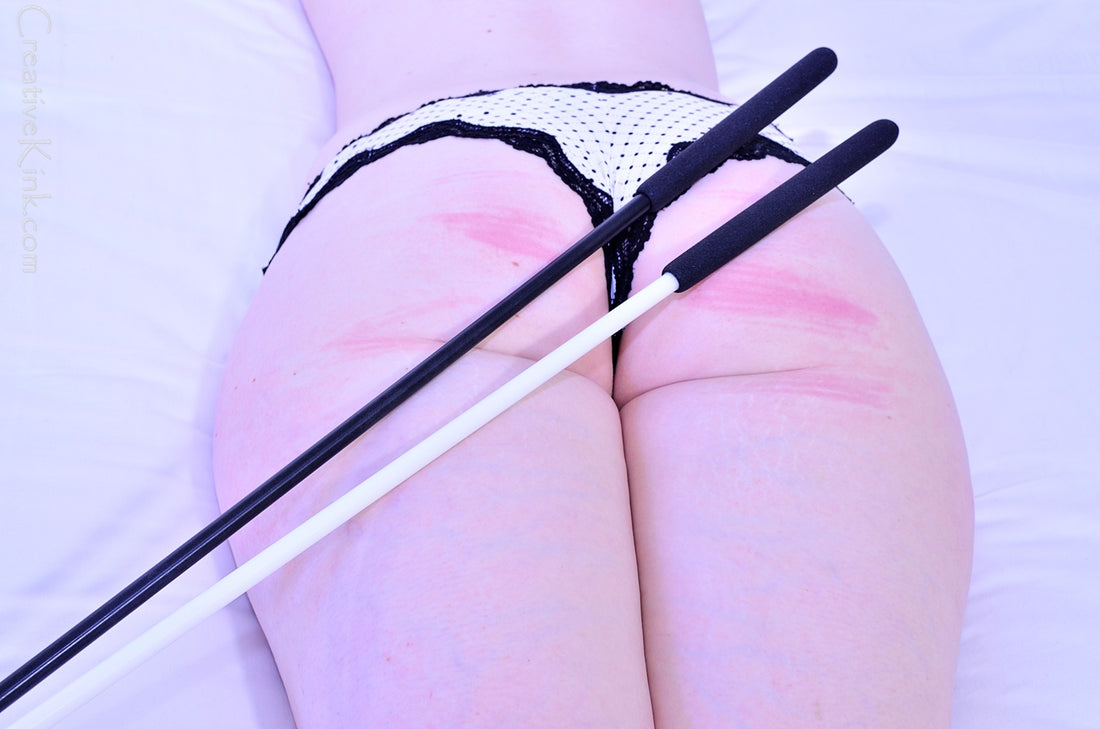
Common Sense About Selecting Canes -- from cK's Caning Files...
Kenova MatthewPorsches are fast, but they suck gas like a whore when the rent’s due. Mini-vans have great interior room, but they’re “conformist”. Muscle cars look great and sound great – but you’ll have to do tons of maintenance.
Canes are tools. So are paddles. And spreader bars, and bondage furniture, and vibrators and all the other lovely toys we use in our lifestyle. They have a specific use, a range of sensation they can cover, and a set lifetime.
See if you buy the cheapest vibrator on a site – don’t be surprised if it doesn’t have much power. If you buy a steel paddle, don’t be shocked if it does serious damage to your beginning-submissive’s hide. And if you buy a light weight cane, don’t be shocked when it breaks as you use it for heavy duty caning.
Caning has a technique to it. A skill set. Learn the techniques, and you’ll get your money's worth (and your kink's worth) out of every cane you ever buy. Just go whacking away on asses with them – and you’ll go through a LOT of these toys before (probably) giving up on canes.
Materials:
Wood. Wood canes are a warm up on heavy masochists, a Victorian sexy prop for scene play, and a wicked, affordable cane for beginners. But if you use a wooden cane like it’s a poly cane you’re going to wind up feeling cheated by the scene and the cane. They create beautiful welts, and a sharp nasty sting that anchors you right down with Authority (by god!).
Wood canes should also be cared for, occasionally rubbed with linseed oil to keep the wood flexible. Dried canes can crack – so if your cane breaks, it’s either being used too hard, or it was allowed to go dry. They do tend to be the lower end of cost, in terms of canes.
Rattan. Rattan canes are also basic. They’re lighter than most woods, with a higher flexibility. They can be used for heavier play (in thicker widths), but they need to be cared for to get the most out of them. They don’t have the same strict-straight-authority as wood, but they are definitely nice to have. They can be a lot more forgiving when the cane is wrapped or hits at a bad angle.
Rattan also requires caring for – again, linseed oil rubbed, and the occasional sanding to allow the oil to penetrate more deeply. They also tend to be the lower end of expense, in terms of canes.
Acrylic, AKA Lucite. There are going to be people (generally sales people) who will tell you Acrylic is no different than Delrin or Poly. Smack them. Hard. Acrylic is on the lower end of cost for canes, for a reason.
Acrylic has some major differences, from the kink perspective. Acrylic has a tendency to shatter or crack with repeated hard impacts. But…acrylic stays clear, and attractive, for longer than poly. It makes great designer canes, and transmits light well for “rave” canes. It bends with more forgiveness than poly too. Poly picks up scuffs quickly compared to acrylic. And acrylic is definitely less expensive.
Delrin, AKA Acetal resin. Delrin canes are made from an extruded acetal resin, which means they are extremely flexible, with great resistance to stress damage. So you can use them heavily – as long as you aren’t wrapping them, and as long as you check them every few play times to make sure they’re still bending properly.
Delrin canes are for heavier play, and heavier masochists. You wouldn’t want to use Delrin for a warm up (unless they’re an iron-ass), or for a beginner – but you wouldn’t want to use wood or rattan for a heavy masochist either. Delrin canes require no care other than the occasional check to make sure they haven’t started wearing out. They are in the mid-range of cost, for canes.
Polycarbonate, aka Lexan. Poly canes are heavier than both Delrin and acrylic. It ranges, depending on the person making it, from heavy and flexible, to hard and heavy as a rock. (Poly on the hard end is what they make bulletproof glass from.)
Poly canes are great because they really leave a heavy and deep impact. They bounce enough that you can get a repeating pattern of impacts going quickly. Again, it’s not a warm up or beginner toy – but great for repeating use. Again, poly canes require no major ongoing care. They are in the mid- range of cost, for canes.
Fiberglass. Fiberglass canes are, literally, a bitch. They have a a weight and density that rivals metal canes. Fiberglass canes are unforgiving and like the wooden canes they have Authority to them. That said, they can get brittle over time - look over the cane every few months to make sure it hasn’t developed cracks or wear. They tend to run on the mid-range in cost, and require more skill to use than a wood or rattan cane.
Metal. Aluminum and steel canes are for serious masochists. Aluminum is light weight (most blends, at any rate), while remaining stiff. (Yes, I said stiff. Reeeally stiff.)
Steel has more weight than aluminum, with similar…stiffness. They both cause deep penetration trauma, resulting in some pretty wicked bruises. They are not for beginners, or warm up – these are canes to build up to! They tend to run in the higher range of cost.
Exotics and Designer Canes. These are case by case. Ask what material they’re made out of – most of the “designer” in Designer cane is in the handle, in lighting through the shaft, or in personalization. Worth it, if you want your own style. View the makers of Designer canes (KJ Canes is one of the best) as artists – when you have the money, their work is worth every penny.